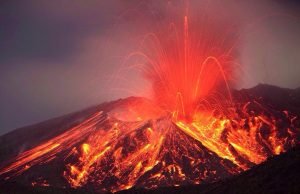
Volcanoes are ... How does a volcanic eruption occur? Interesting facts about volcanoes
It’s hard to find someone who wouldn’t have ever taken interest in volcanoes. Most of them read books about them, with bated breath they watched shots from the places of eruptions, at the same time admiring the power and magnificence of the elements and rejoicing that this was not happening next to them. Volcanoes - this is what leaves no one indifferent. So what is it?
Volcanoes are special geological formations arising from the rise from the depths of the hot substance of the mantle and its release to the surface. Magma rises up cracks and faults in the crust. Where it breaks out, and active volcanoes are formed. This occurs at the boundaries of the lithospheric plates, where faults occur due to their separation or collision. And the plates themselves are drawn into motion as the matter of the mantle moves.
Most often, volcanoes have the appearance of conical mountains or hills. In their structure, the mouth is clearly distinguished - a channel through which magma rises, and a crater - a recess at the top, through which lava flows. The volcanic cone itself consists of many layers of products: frozen lava, volcanic bombs and ash.
Since the eruption is accompanied by the release of hot gases, glowing even during the day, and ash, volcanoes are often called "fire-breathing mountains." In ancient times, they were considered the gateway to the underworld. And they got the name in honor of the ancient Roman god Vulcan. It was believed that fire and smoke fly from its underground forge. Such interesting facts about volcanoes fuel curiosity among a variety of people.
Volcanic eruption as a geological process

An eruption is considered to be the process of ejection of hot magmatic products in the solid, liquid and gaseous state to the earth's surface. For each volcano, it is individual. Sometimes the eruption is quite calm, the liquid lava flows in streams and flows down the slopes. It does not interfere with the gradual release of gases, so strong explosions do not occur.
This type of eruption is characteristic of Kilauea. This volcano in Hawaii is considered one of the most active in the world. Its crater with a diameter of about 4.5 km is also the largest in the world.
If the lava is thick, it clogs the crater from time to time. As a result, the released gases, not finding a way out, accumulate in the vent of the volcano. When the gas pressure becomes very high, a powerful explosion occurs. It lifts into the air large amounts of lava, which subsequently falls to the ground in the form of volcanic bombs, sand and ash.
But the most powerful explosion that led to a cooling in the whole world due to volcanic clouds, through which the sun's rays could hardly penetrate, occurred in 1883. Then the Krakatau volcano lost most of its part. A pillar of gas and ash rose to 70 km up. The contact of ocean water with red-hot magma led to the formation of a tsunami up to 30 m high. In general, about 37 thousand people became victims of the eruption.
Posted from my blog with SteemPress : https://dlivevsteemit.000webhostapp.com/2018/11/volcanoes
Source 1.
Source 2
Direct translation without giving credit to the original author is Plagiarism.
Repeated plagiarism is considered spam. Spam is discouraged by the community and may result in action from the cheetah bot.
More information on Image Plagiarism
If you believe this comment is in error, please contact us in #disputes on Discord
Please note that direct translations including attribution or source with no original content is also considered spam.
Congratulations @dlivev! You have completed the following achievement on the Steem blockchain and have been rewarded with new badge(s) :
Click here to view your Board of Honor
If you no longer want to receive notifications, reply to this comment with the word
STOPDo not miss the last post from @steemitboard: